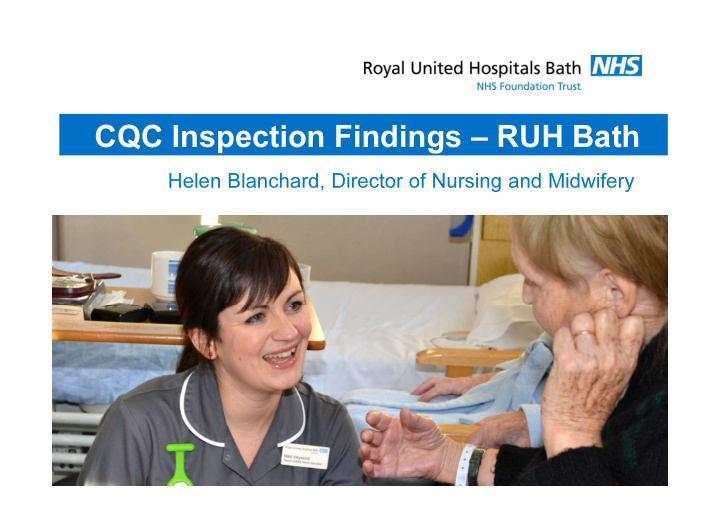



CQC Inspection Findings – RUH Bath Helen Blanchard, Director of Nursing and Midwifery
Background � The CQC carried out an inspection of the Royal United Hospitals Bath NHS Foundation Trust in March 2016 � Inspection report based on: � Data from local Clinical Commissioning Groups and Monitor (now NHS Improvement) � Findings from the inspection – observations, discussions with staff, patients, relatives � Data held by the CQC including from the Provider Information Requests
Summary of ratings � Inspection report highlights many areas of good and outstanding practice: � End of life care and the caring domain rated as ‘outstanding’ � Leadership, governance and safety culture promoting high quality person-centred care � Good coordination of care � Of the 53 indicators represented by the core services and CQC domains: 3 rated as ‘outstanding’ 36 rated as ‘good’ 14 rated as ‘requires improvement’
Areas for improvement � Some areas for improvement identified including: � Staffing levels � Pressures in urgent and emergency care � Patient flow � The main areas for improvement relate to Urgent and Emergency Services, Medical Care and Critical Care � An improvement plan is being implemented to address the areas of concern identified by the CQC
Urgent & Emergency Services Requires improvement Actions taken / planned Reporting on triage of self- • Report added to the daily validation report presenting patients • Continue training in use of the Manchester Triage tool Record keeping including pain • Nursing documentation reviewed and checklist assessments and early warning introduced score • Further NEWS training • Regular auditing Nurse staffing levels • Staffing levels reviewed including skill mix • Continue proactive recruitment to vacancies Ensure all staff are up to date with • Electronic staff record amended to reflect correct staff mandatory training groups in training reports • Monthly review of training by Clinical Lead and Matron
Critical Care Requires improvement Actions taken / planned Delayed discharges to wards and • Working group established to identify themes and lead actions discharges at night Review of equipment to ensure all • Equipment spreadsheet created to monitor servicing maintenance and servicing is up to • Daily checklist for checking of equipment date Employment of Critical Care Matron • Matron appointed and commenced in post & nursing levels • Protecting the admitting nurse & nurse in charge status Business Case to be submitted (2 nd Supervisory Nurse) • Storage and checking of medicines • New Digi Lock fridge & digilocks to the drug cupboards • Adaptions to resus trolleys to be tamper compliant. Cleanliness • Declutter, deep clean & afternoon cleaning hours • Weekly dual cleaning audits (domestic & nursing) Incident reporting – staff • Monthly governance meetings including incidents awareness, reporting and feedback • Demonstrable increase in incident reporting & feedback to staff Ensure policies, guidance and • Removal of paper copies (electronic only) protocols are up to date • Review policy/procedure/guidance through governance meetings
Medical Care Requires improvement Actions taken / planned Care records and documentation • Weekly audits including risk assessments, care • Nursing handovers include documentation review plans and monitoring records • Senior sister walk round includes documentation review Ensure appropriate medical care • SOP for consultant cover clinically for medical patients is provided to patients transferred staying at the RNHRD to the RNHRD • Audit of transfer of patients • Implementation of ward round check list Nurse staffing levels and staffing • Annual skill mix review with Head of Nursing for Medicine, reviews Matrons and Senior Sister to ensure appropriate skill mix / time of shift patterns • Established an operational Safer Nurse Staffing Group led by the Lead Nurse for Workforce Development Ensure staff are aware of the • Major incident training now provided on induction major incident protocol
Recommend
More recommend